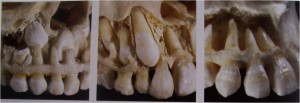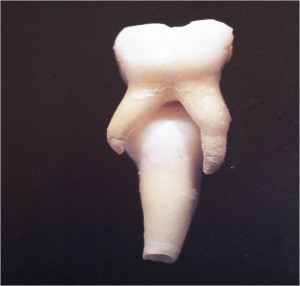Impacted Maxillary Canines
Natural Development of Canine

Continue reading
What is Impacted Tooth?Â
An impacted tooth is any tooth that is prevented from reaching its normal position in the mouth by tissue, bone, or another tooth.
Why do impactions occur?
Theories & mechanisms of tooth impaction

Continue reading
X-RAY FILMS
Introduction
X-ray film is an image receptor.
It is a type of photographic film, in which an image is formed by
the exit radiation exposing the film.The film is composed of 2
principal components namely the base& emulsion.
Base:
0.2 mm thick & made up of clear, transparent cellulose acetate or
Cellulose nitrate.Cellulose acetate is used because it is less
inflammable. Recently polyesters [polyethylene teraphthalate] are
used.The base should be flexible for easy handling{manipulation}.
Emulsion:Consists of homogenous mixture of gelatin & silver
halide crystals.The gelatin is made from cattle bone.The gelatin is
clear so that it will transmit light & sufficiently porous to allow the
processing chemicals to penetrate it & reaches the silver halide crystals fast without affecting the strength.
Bremsstrahlung radiation

In an X-ray tube the electrons emitted from the cathode are accelerated towards the metal target anode by an accelerating voltage of typically 50 kV.
The high energy electrons interact with the atoms in the metal target.
Sometimes the electron comes very close to a nucleus in the target and is deviated by the electromagnetic interaction.
The electrons move in this direction because of the strong electrical field between the negatively charged cathode & the positively charged anode.
The X- ray tube is evacuated completely as possible to fascilitate movement of these high speed electrons
Introduction
Generation, emission & absorption of radiation occurs at the subatomic level.
Nucleus- two particles- protons & neutrons [nucleons].
Particles that orbit the nucleus are the electrons.
Interest to diagnostic radiology- electrons, protons & neutrons.
number of protons- nucleus of atom- atomic number [Z].
total number of protons & neutrons – nucleus of an atom- mass number [A].
LEUKO : WHITE PLAKIA : PATCH
WHO:1967
Defined as a raised patch of the oral mucosa measuring 5 mm or more, which cannot be scraped off and which cannot be attributed to any other diagnosable disease.
(This definition did not carry any histological connotation)
WHO 1978
Def : modified
Leukoplakia was defined as a white patch or plaque that cannot be characterised clinically or Pathologically as any other disease.
(Term is unrelated to absence or presence of dysplasia)
Continue reading
PREDISPOSING FACTORS
Candidal infection, with the exception of neonates , usually does not become evident in healthy persons.
Intact mucous membranes prevent candidal infection.
When host’s local or systemic defence mechanism are weak, commensal or acquired candidal organism becomes pathogenic.
INFECTIOUS WHITE LESIONS , WHITE & RED LESIONS
ORAL HAIRY LEUKOPLAKIA
Corrugated white lesion that usually occurs on the lateral or ventral surface of the tongue in patients with severe immunodeficiency
Most common associated disease is HIV infection
Present in 25% of adults with HIV infection but is not as common in children
Prevalence reaches 80% in AIDS
Epstein-Barr virus is implicated as the causative agent
Occasionally reported in patients with other immunosuppressive conditions (patients undergoing organ transplantation, or on prolonged steroid therapy)
Rare cases may occur in immunocompetent persons after topical steroid therapy
ACTINIC KERATOSIS (CHEILITIS)
Also known as solar keratosis
Premalignant epithelial lesion directly related to long-term sun exposure
Classically seen on the vermilion border of the lower lip as well as on other sun-exposed areas of the skin
10% of these will transform into squamous cell carcinoma
Biopsies should be performed on lesions that repeatedly ulcerate, crust over, or show a thickened white area
Seen in individuals with extensive sun exposure and/or fair complexions